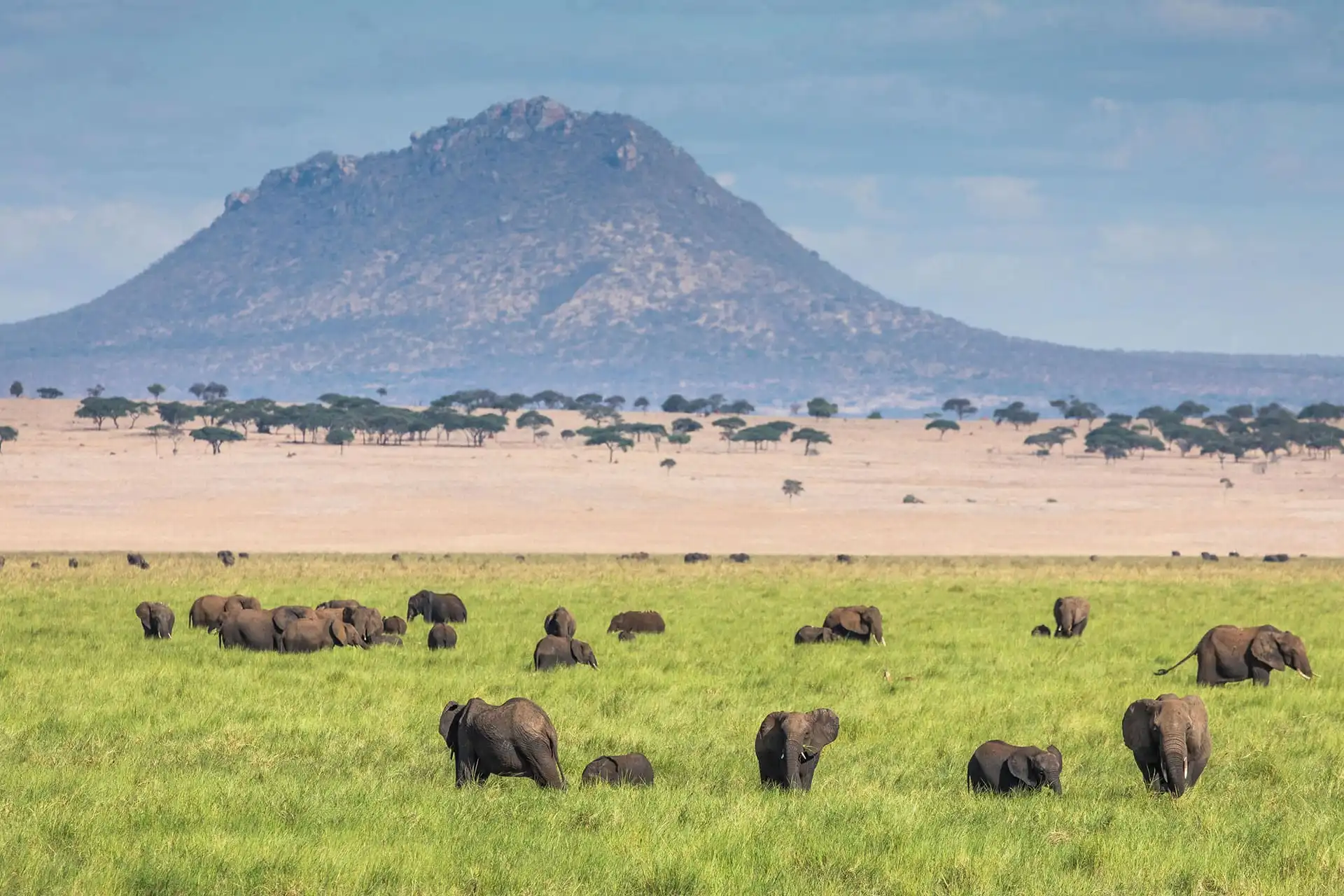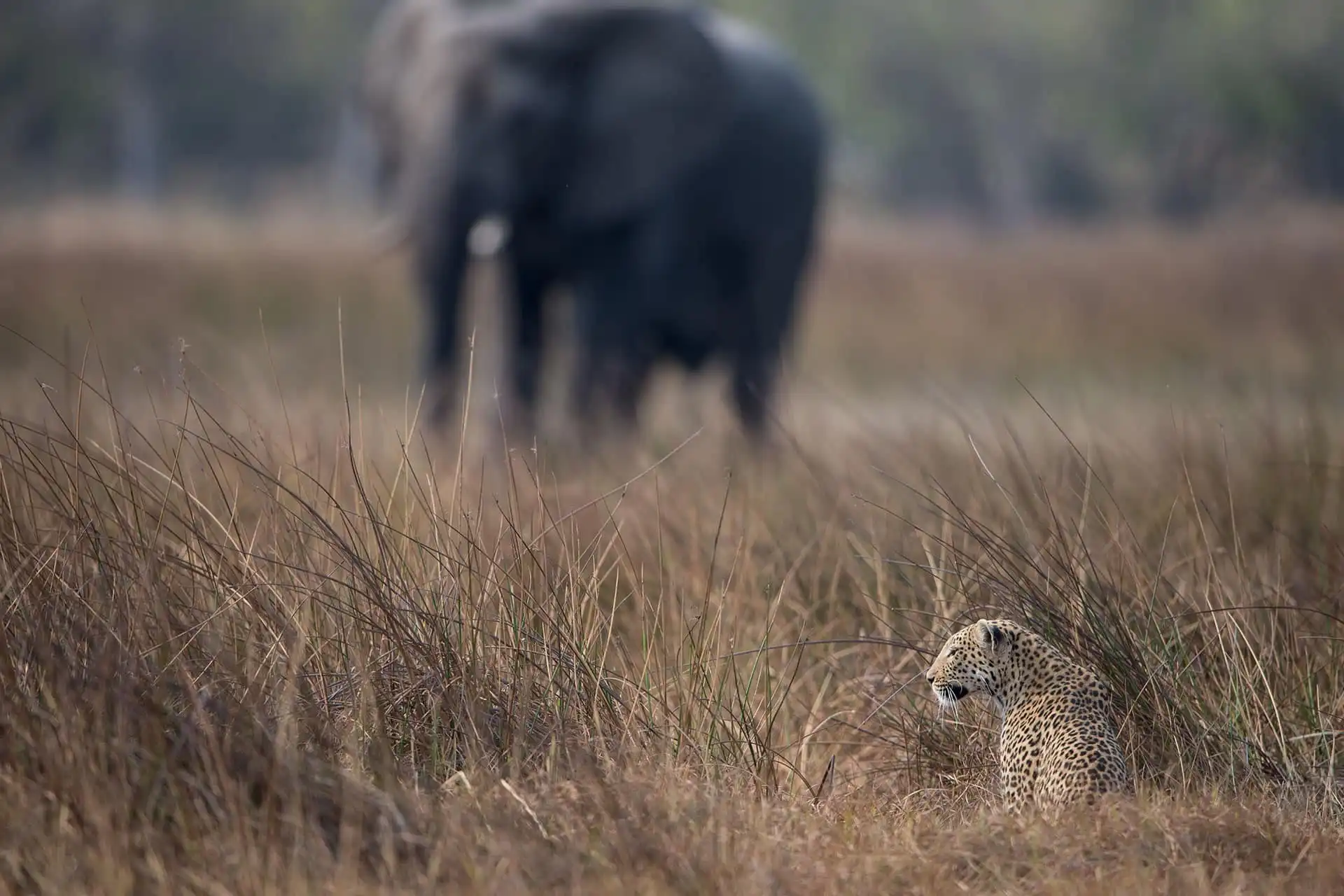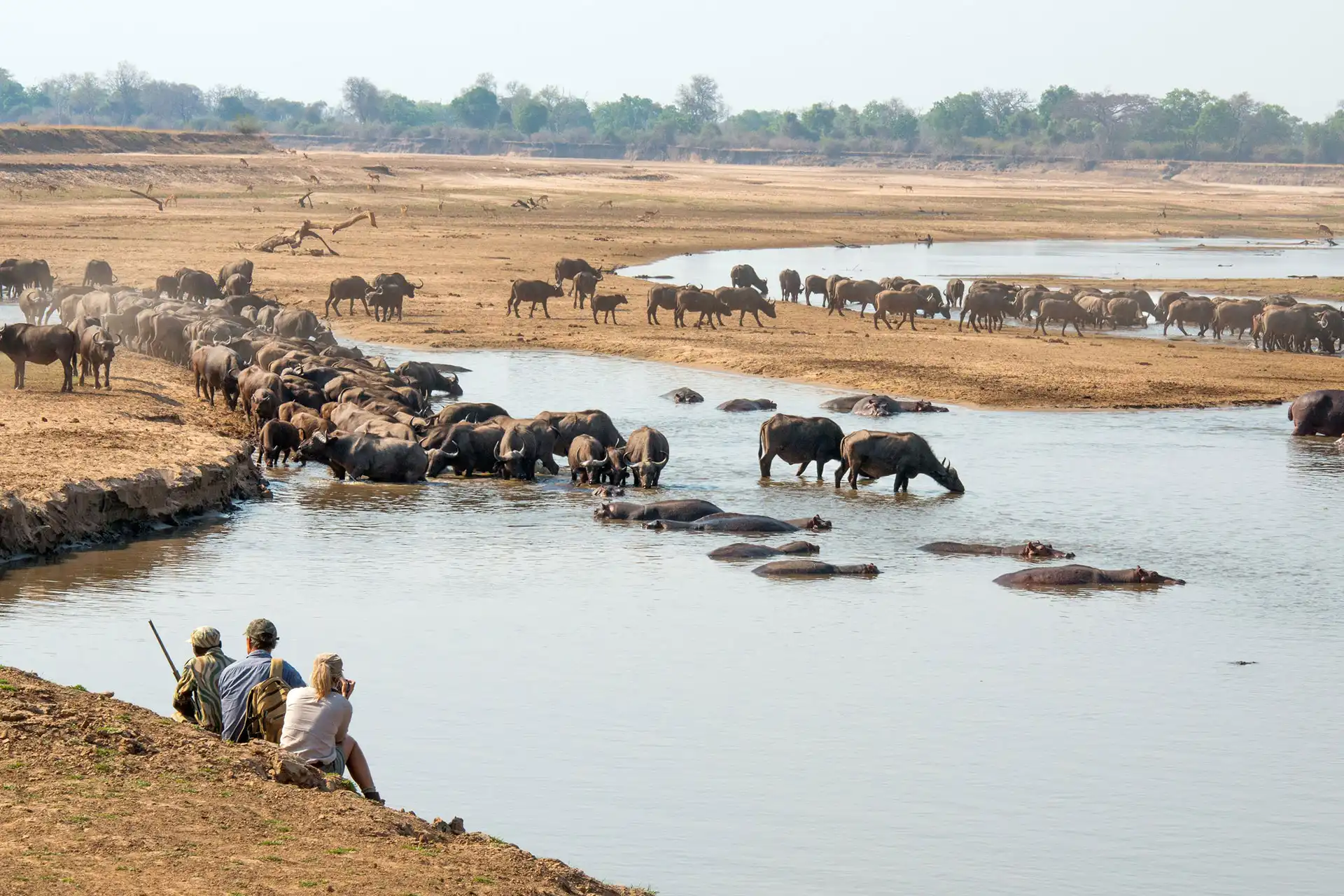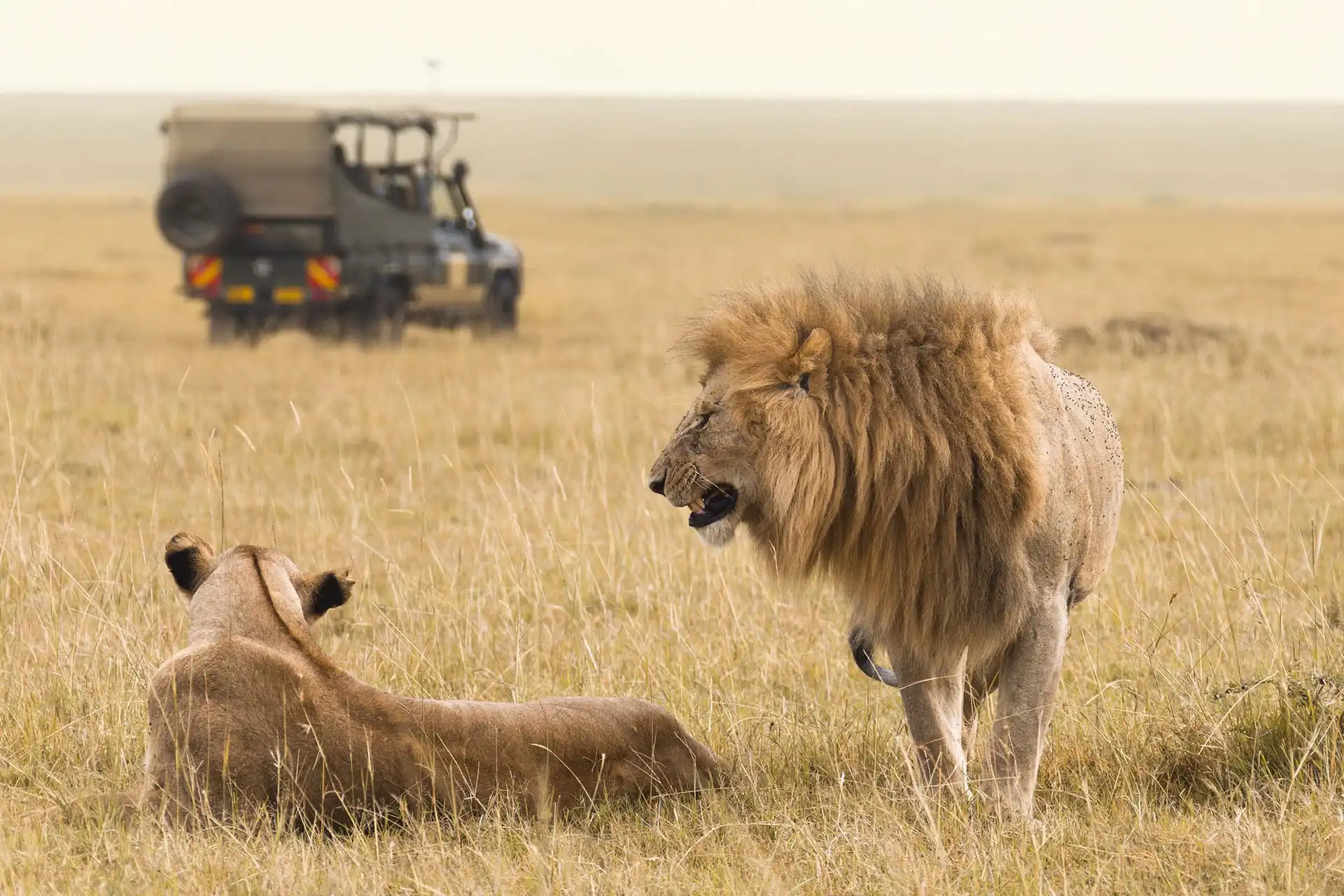The Icons of Africa – Big Five
Written by
Ker & Downey® Africa
The formidable Big Five of Africa are a bucket list must for any traveler. These are the safari heavyweights, and are so highly-sought after that they even grace the banknotes of the South African currency.
The term, Big Five, originated centuries back and was coined by big game hunters who saw these five large African mammals as being the most dangerous to hunt, and therefore the most prized. Their reputations as crafty animals, with strong survival instincts made them lethal adversaries to hunters, difficult to track, and very dangerous when confronted. They are the rhinoceros, African elephant, lion, buffalo, and leopard.
Today, the name takes on a gentler form, and these majestic animals are protected, revered, and considered to be icons in Africa. Sightings of the Big Five are unforgettable experiences for travelers to Africa who travel far and wide, armed with cameras and not guns, to capture the magnificence of their presence in the wild.
While there are no guarantees that you will see all of the Big Five animals during a safari in Africa, there are some notable destinations and private reserves that contain larger populations and offer some dramatic sighting opportunities. Some of these destinations include the world-renowned Kruger National Park in South Africa, Chobe National Park in Botswana, Kenya’s Masai Mara, and the Serengeti in Tanzania.
Talk to one of our expert LuxVenture® designers today about some of our recommended destinations that deliver the best Big Five experiences on the continent, and come face-to-face with the real icons of Africa.
African Elephant
The majestic African elephant is the largest terrestrial animal on the planet, and also one of the most intelligent and socially intricate. This emotionally advanced giant is characterized by its strong, prehensile trunk; thick hairless skin; curved ivory tusks; and large fan-shaped ears. Despite existing off an entirely vegetarian diet, the African elephant can grow up to 15 feet (4 m) in height, and weigh up to 15,000 pounds (6,800 kilograms), consuming up to 440 pounds or 200 kilograms of forage each day and drinking up to 190 litres of water.
These socially intelligent animals display empathy toward one another, become visibly depressed when a member of the herd dies, and can become aggressive (and potentially charge) when their youngsters are compromised. Sadly, illegal hunting, the ivory trade, and loss of habitat are jeopardising this magnificent creature’s chances of survival, but strong conservation efforts in and around Africa are underway to reduce the illegal trade of ivory, put an end to poaching, and find new protected areas and safe havens for one of Africa’s most iconic animals.

A herd of African elephants
African Leopard
The leopard is the most stealthy, secretive, and shy member of the Big Five. Known most famously for their striking coats which are light in color with distinctive spots (or rosettes), the leopard is the third largest member of the wild cat family characterized by a muscular build, short stocky limbs, and a broad head. These experienced carnivorous hunters are solitary animals, and are only seen together during mating season.

A solitary African leopard
Leopards are agile creatures and exceptional tree climbers who can drag their prey – weighing up to three times their body weight – up into trees of over 20 feet (or 6 meters). They are often seen napping in trees, and sometimes even hunt from them. Most active between sunset and sunrise, these nocturnal felines have excellent night vision and are mostly found in the savanna grasslands, brush land and forested areas in Africa.

Leopards are agile creatures and exceptional tree climbers who can drag their prey – weighing up to three times their body weight – up into trees of over 20 feet
Cape Buffalo
While buffalos may seem like unassuming, placid and sedentary creatures, these giant herbivores are in fact the most dangerous members of the Big Five. Cape buffalos, or African buffalos, are moody and have unpredictable temperaments which result in them charging, goring, trampling and killing unrepentantly and for no apparent reason. They are said to have killed more hunters in Africa than any other animal, and have earned the nickname “Black Death”.
These formidable-looking animals are characterized by their imposing curved horns, which have fused bases, forming one long and strong continuous helmet across the top of the head, referred to as a “boss”. Found mostly in southern and central Africa, they spend most of the year in herds of anywhere between 50 and 500, finding even more power in numbers against predators like lions, leopards, hyenas, and African wild dogs.

Buffalo herd at Kaingo Camp, Zambia
Lion
The apex predator of the wild, lions are an iconic symbol of Africa. Powerful and majestic, these tawny-coated carnivores are the most social of the big cats, and are mostly found living in large groups called prides. The male lion has a larger frame than the female, and wears a magnificent mane around his neck and shoulders.
Though often described as the king of beasts, it is in fact the female lioness who does the hunting, strategically working in packs to target their prey. Prides are also run by generations of females who, again, work together to defend their territory, while males leave home when they are young to conquer new prides and fight other males to establish hierarchy. It is always a spectacular sight witnessing these incredible creatures in their natural habitat, even when they’re sleeping – a favorite pastime that sometimes lasts up to 20 hours per day.

A male and female lion spotted on a safari
Rhinoceros
The powerful, robust rhinoceros, characterized by two large upright horns in the middle of its face, is said to be the second largest land animal after the elephant. These short-sighted temperamental tanks can be extremely dangerous and can charge anything they deem to be a danger to them at full force, using their sharp horns as lethal weapons. There are two species of rhinoceros in Africa: the white rhinoceros, and the black rhinoceros.
The black rhino is distinguished by a prehensile or hook-lipped mouth, adapted for feeding from trees, while the white rhino has a wider, more square-lipped mouth shape for grazing. Both are extremely endangered animals, having suffered the most drastic decline of all due to their highly-sought after horns which are used in Asia medicinally, and as aphrodisiacs. Poaching remains their biggest threat, but massive conservation efforts are underway to protect this national icon.

Rhino at Lake Manyara National Park, Tanzania
Get in touch with one of our expert LuxVenture® designers today to start planning your Big Five safari to Africa, and one of the most unforgettable experiences of your life!
Curated Packages
Signature journeys across Africa
Our expert team crafts journeys that transcend luxury. Each itinerary is shaped by the spirit of the land and the wisdom of its people — opening doors to experiences few can imagine, and even fewer will ever access.
All Year Round
|
17 DAYS
Southern Africa: Framed and Untamed
From
per person
All Year Round
|
12 DAYS
Tanzania & Zanzibar Honeymoon Safari
From
per person
All Year Round
|
11 DAYS
Cape Town Safari & Whale Coast Adventure
From
per person
All Year Round
|
Day Trip to Antarctica LuxVenture®
From
per person
July-September
|
6 DAYS
Horseback Safari in Kenya
From
per person
All Year Round
|
13 DAYS
Elephant Safari in South Africa, Victoria Falls & Botswana
From
per person
Jan, Feb, Jun – Sept
|
5 DAYS
Mountain Gorilla Trekking in Rwanda
From
per person
All Year Round
|
10 DAYS
Luxury Tanzania Honeymoon LuxVenture®
From
per person
All year round
|
12 DAYS
Luxury Family Safari: South Africa & Victoria Falls
From
per person
All Year Round
|
14 DAYS
Southern Africa’s Finest: SA, Victoria Falls & Botswana
From
per person
All Year Round
|
13 DAYS
Amboseli, Lewa and Masai Mara Safari
From
per person
June - Sept
|
15 DAYS
Gorillas & Big Five Safari Adventure
From
per person
All Year Round
|
12 DAYS
South Africa Art, Wine & Wilderness Safari
From
per person
All Year Round
|
9 DAYS
Luxury Adventure through Namibia
From
per person
Feb – May, Sep – Dec
|
10 DAYS
Luxury Journey Through Morocco
From
per person
All Year Round
|
7 DAYS
Luxury Gorilla Trekking Safari in Rwanda
From
per person
June-October
|
9 DAYS
Sub Saharan Kenya Safari Experience
From
per person
April-October
|
10 DAYS
Best of Botswana Safari
From
per person
June – October
|
18 DAYS
Tanzania and Seychelles Luxury Safari
From
per person
All Year Round
|
9 DAYS
Luxury Safari in Kruger National Park & Cape Town
From
per person
March-December
|
10 DAYS
Luxury Private Safari in Zambia
From
per person
All Year Round
|
10 DAYS
Botswana & Victoria Falls Adventure
From
per person
June-October
|
10 DAYS
Electric Vehicle Safari in Kenya
From
per person
March to June
|
10 DAYS
Zimbabwe Victoria Falls & Safari LuxVenture®
From
per person
15 June - 15 November
|
7 DAYS
Luxury Tented Safari in Tanzania
From
per person
All Year Round
|
16 DAYS
Ultimate East Africa Safari
From
per person
All Year Round
|
11 DAYS
Luxury Safari in Zambia
From
per person
Year Round
|
15 DAYS
The Ultimate Southern Africa Bush & Beach
From
per person
All Year Round
|
7 DAYS
Chobe River Cruise & Okavango Delta Safari
From
per person
All year round
|
9 DAYS
Beaches of Seychelles Vacation
From
per person
Year Round
|
10 DAYS
Natural East Africa Wonders Safari
From
per person
June-October
|
9 DAYS
The Great Wildebeest Migration Safari in Tanzania
From
per person
All Year Round
|
6 DAYS
Luxury Morocco Vacation
From
per person
All Year Round
|
9 DAYS
Botswana Okavango Honeymoon LuxVenture®
From
per person
All Year Round
|
10 DAYS
Cairo + Luxury Nile Cruise
From
per person
All Year Round
|
8 DAYS
Luxury Kenya Safari
From
per person
May to October | November to April
|
11 DAYS
Spirit of Zambia Safari
From
per person
June-October
|
8 DAYS
Tanzania Northern Circuit Safari
From
per person
All Year Round
|
14 DAYS
Luxury South Africa and Mozambique Honeymoon
From
per person
All Year Round
|
8 DAYS
Fly-in Luxury Namibia Safari
From
per person
June-February
|
13 DAYS
A Cultural Safari Tanzania Zanzibar
From
per person
All Year Round
|
12 DAYS
Stargazing Desert Safari in Namibia
From
per person
June-October
|
7 DAYS
African Wild Dog Safari
From
per person
May-October
|
8 DAYS
Luxury Treehouse Safari to Botswana LuxVenture®
From
per person
Jan, Feb, Jun – Sept
|
13 DAYS
Gorilla Trekking, Ngorongoro Crater & Serengeti
From
per person
All Year Round
|
8 DAYS
Best of Egypt LuxVenture®
From
per person
All Year Around
|
12 DAYS
Tanzania and Zanzibar Safari
From
per person
All Year Round
|
17 DAYS
Luxury Mauritius & South Africa Experience
From
per person
Year Round
|
18 DAYS
Southern Africa Luxury Bush & Beach Escape
From
per person
Year Round
|
8 DAYS
African Wild Dog Safari in Zimbabwe
From
per person
All year round
|
9 DAYS
9-day Victoria Falls to Botswana Luxury Safari
From
per person
June-August
|
12 DAYS
Rovos Rail and Zambezi River Escape
From
per person
All Year Round
|
10 DAYS
Tanzania & Zanzibar Family Holiday
From
per person
May to October
|
8 DAYS
Mad Max Safari Adventure
From
per person
All Year Round
|
11 DAYS
Luxury Egypt Experience
From
per person
All Year Round
|
9 DAYS
‘Out of Africa’ Safari in Kenya
From
per person
June - Sept
|
11 DAYS
Uganda Done Right
From
per person
June - Sept
|
8 DAYS
Rivers & Rainforests: A Ugandan Safari
From
per person
All Year Round
|
12 DAYS
Culinary Journey to Morocco
From
per person
Dec – Mar
|
7 DAYS
Wildebeest Calving Season Safari
From
per person
May-October
|
10 DAYS
South Luangwa Walking Safari
From
per person